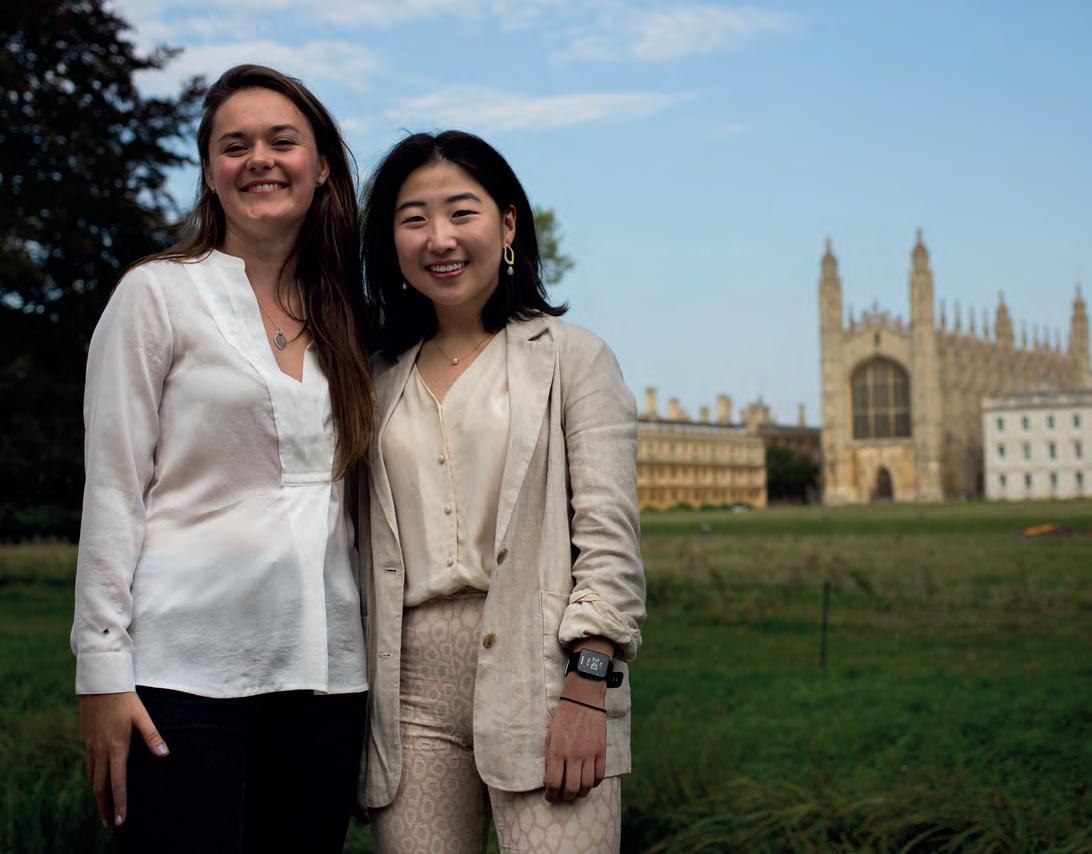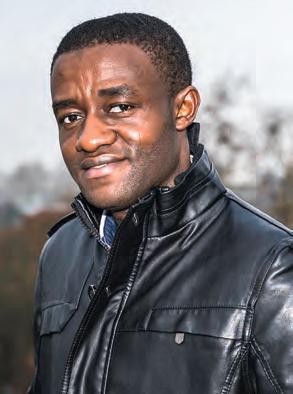
5 minute read
_________________________________________________________ Students get involved _________________________________________________________
PhD students June Park and Amy Rochford won rst prize in the Wolfson Enterprise Competition in May for their start-up Lecta, which is developing bio-fabricated regenerative exible electronics for neural interfaces.
Wolfson Enterprise Competition winners Amy Rochford (left) and June Park rst started thinking about Lecta over dinner at King’s College (background).
June, a Gates Cambridge Scholar and NanoDTC Associate, is in the third year of her PhD in the Scherman group and received her BSc in Chemical and Biological Engineering from MIT. Her work involves designing viscoelastic supramolecular hydrogels for stem cells, speci cally for cell therapy. Amy, who is in the third year of her EPSRC DTP PhD in the Department of Engineering, studied Biomedical Science as an undergraduate and holds a Master’s in Regenerative Medicine and Nanotechnology. Her research involves bio-hybrid technologies, which combine living cells with exible electronics.
June and Amy, who are both at King’s, explain how they got the idea for Lecta over a college dinner: “We were discussing a day in the lab plagued by slippery bioelectronic device surfaces,” says Amy. “I was having a problem with my research and I needed the assistance of a chemist to help me with sticking hydrogels to exible electronics.”
“And we realised that with my background in chemical engineering and now hydrogels, and Amy’s in exible bioelectronics, we could work together to come up with a solution,” says June.
Their solution combines surface chemistry, chemistry-based biomaterials, and stem cells with exible electrodes to generate bioelectronic devices. June explains: “It’s like trying to combine jello with cling lm – there’s no way to do it without some sort of chemical interface.”
The pair realised that with this new chemistry, they could design implantable devices, which because of their biomimetic coating, are less likely to trigger the body’s natural immune-response. “The problem is the human body ghts o implants with an immune-response known as ‘foreign body response’,” explains June. “This results in brotic capsules being created around implanted devices, so they can’t work e ectively.”
Some months after their initial collaboration, the researchers saw an ad for a business competition, “and that’s how we began.”
“We believed in what we were doing so it was just a big leap – and perseverance. The idea of starting a business is scary, but we just went for it. We had nothing to lose and wanted to give it a shot,” says Amy. They applied to one previous business competition. “That was a process we learned from and going through that as a team we helped each other grow. And that helped us realise we had a really strong team working relationship, as well as friendship. So go out and have lots of dinners with your friends!”
The new biomaterials may not only ameliorate some of the brotic side e ects of the implants, but excitingly they also appear to support stem cell growth. “Stem cells are nicky and di cult to grow even on tissue cultures, but our chemistry provides the environment that allows the stem cells to grow. So now our aim is to shift the devices from purely treatment of symptoms, to disease-modifying and even regenerative,” says June. “Curative regenerative technology is very exciting right now.” Their ten-year goal is to have the new devices in clinical trials, if not already reaching patients. “Working with materials that are already clinically approved is a realistic goal,” says Amy.
Both researchers have family backgrounds that introduced them to entrepreneurship from an early age. “My Dad is an inventor – he’s a bit of a crazy scientist, and we used to sit together and get parts from a junkyard and build things,” says June. At age 12 she took her rst entrepreneurial step when she sold a ltration system they created to a neighbour. Amy says: “My Dad is an engineer and entrepreneur. He’s inspired my ve sisters and I to go into business one day.” June’s experience working in healthcare consulting, and Amy’s with a UCL spin-out have also prepared them well.
“The competition has also been really useful for us,” says Amy. “The rst exercise of doing a business canvas made us really think about what was important about taking our business forward. And the pitch was useful too – it gave us ideas on how to communicate our idea.” June adds: “We were able to engage with non-scientists who asked good questions that challenged us and helped us think about our plans, and we met some great mentors.”
The wider Cambridge environment also helps. “We hear a lot about the Cambridge ecosystem, and it’s during competitions like these that you realise how much it exists, and how so many of us share the same excitement for entrepreneurship,” says June. Amy adds: “Cambridge is good because it gives you opportunities to have a drink or a meal and discuss your work with each other--because we’re in two di erent departments, I don’t know how we would have met otherwise.”
Additionally, Cambridge Enterprise put the team into contact with resident experts and advisors in the health care eld, and helped them assess their patent strategy. CE sponsored part of the WES competition and will continue to support the winners.
The new company is called Lecta because: “It’s a feminine form of the Latin word for excellence, and we are two female scientist pursuing excellence,” says June.
“Lecta is an outcome of what we were working on for our PhDs, and has now evolved into a project in itself,” says Amy. “That’s why it feels so dear to our hearts, it combines our expertise, our excitement, and our hopes for the future of medicines. It is both growing out of our PhD and is a personal growth.
“Having founded the Wolfson Entrepreneurs Society and initiated the Enterprise Competition myself, it was great to see a member of the Chemistry Department win the maiden edition!”

PhD student David Izuogu, a theoretical chemist in the Thom group.










